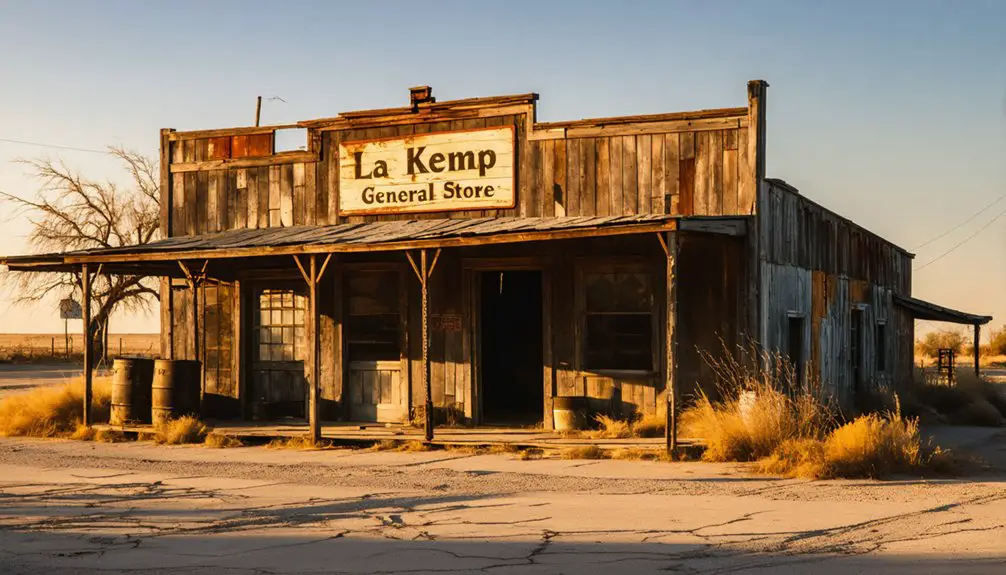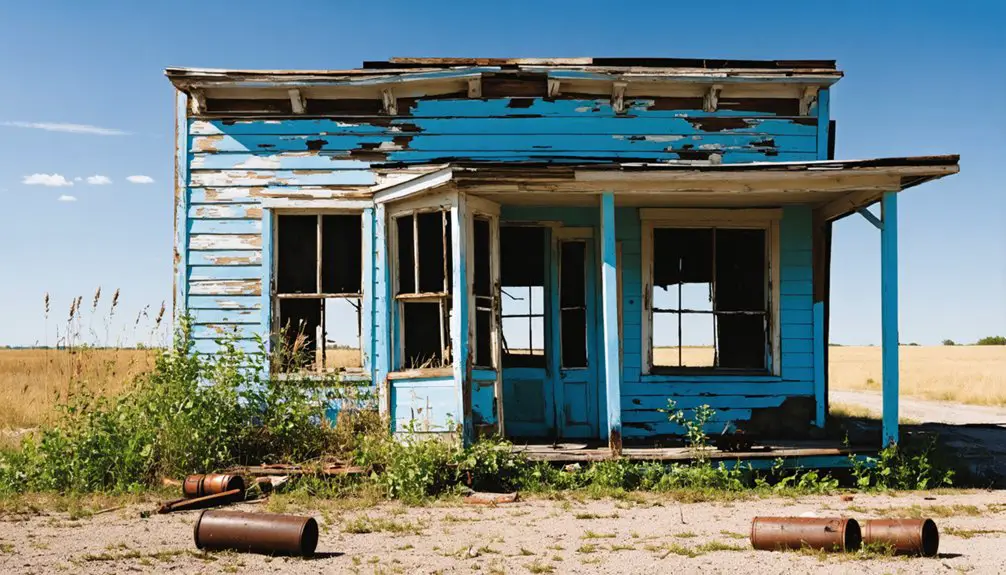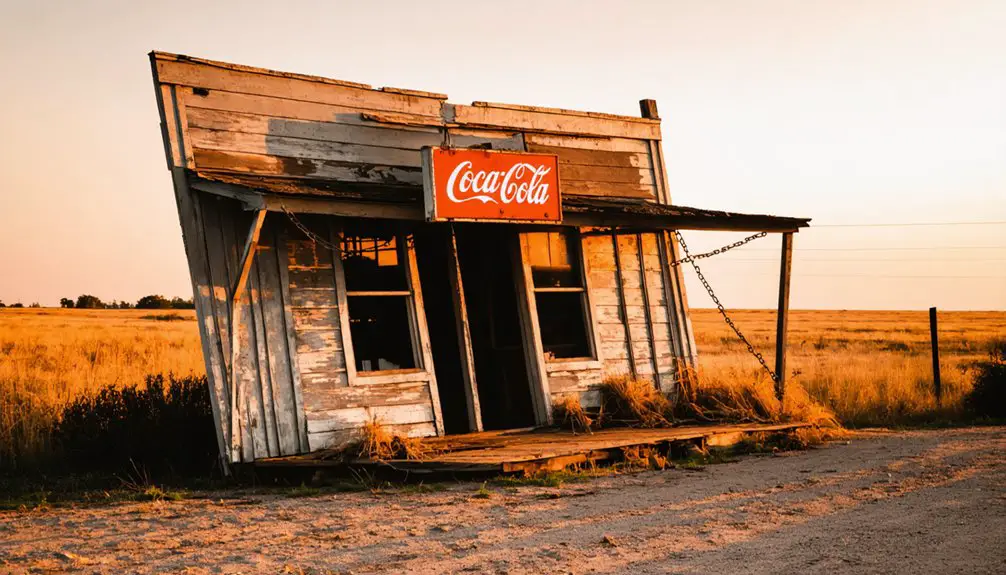You’ll find La Kemp’s fascinating story in early Oklahoma, where a determined community of 500 residents made an extraordinary choice in 1919. Rather than fade away when bypassed by the railroad, they loaded their entire town onto flatcars and moved seven miles south into Texas, renaming it Booker. The original site, established in 1909 with its unique heart-shaped layout near Warner Springs, now stands empty – though its remarkable tale of survival lives on.
Key Takeaways
- La Kemp was established in 1909 in Oklahoma with a heart-shaped layout and thrived initially with 500 residents around Warner Springs.
- The town featured essential services including a post office, bank, grocery stores, and physicians during its peak years.
- Economic pressures from the Dust Bowl and Great Depression forced residents to relocate, leading to La Kemp’s eventual abandonment.
- Most buildings were moved by railroad flatcars to Booker, Texas in 1919 when railway construction bypassed the original town site.
- Only scattered foundations, bricks, and artifacts remain at the original La Kemp site, marking its transformation into a ghost town.
The Birth of a Prairie Town (1909)
Three pivotal events marked the birth of La Kemp, Oklahoma in 1909: its establishment during Oklahoma’s early statehood period, its naming after promoter David L. Kemp, and its shift from the former settlement of Conroy.
You’ll find that town planning reflected the ambitions of a burgeoning prairie community, with its design later formalized by Thomas C. Spearman’s distinctive plat featuring a heart-shaped layout and a unique central road system. Like the town of Kemp, Oklahoma, the area was initially drawn to development because of its natural springs.
The town’s founding population of around 500 residents showed promising community growth, drawn by the promise of railroad expansion and fertile agricultural land. The settlement would later become known as Booker, Texas when it relocated seven miles across the state line in 1919.
La Kemp’s 500 initial settlers were lured by dreams of railway progress and rich farmland in Oklahoma’s promising frontier.
As you explore La Kemp’s origins, you’ll discover how the early infrastructure supported essential services, including a post office and local businesses, establishing the settlement as a crucial hub for trade and commerce in the region.
Life on the Oklahoma-Texas Border
Beyond La Kemp’s early settlement days, you’ll find that border life along the Oklahoma-Texas line created distinctive communities with dual identities.
Towns like Texhoma embodied this unique border culture, where you’d witness a fascinating blend of cowboy heritage, farming traditions, and small-town values spanning two states. You’d see grain elevators dotting the landscape and cattle drives maintaining age-old traditions, while local newspapers like the Texhoma Argus kept communities connected across state lines. The town’s railway depot was strategically built on the state line to serve both territories.
Life here meant adapting to complex jurisdictional realities – with split municipal governments and shared school districts straddling the border. The seasonal temperature extremes made farming particularly challenging, with residents enduring hot summers and cold winters.
Despite population fluctuations and economic challenges, community identity remained strong. Families weathered the hardships of the Great Depression and Dust Bowl together, preserving their distinctive way of life in these freedom-loving border towns.
Economic Growth and Railway Connections
When the Panhandle and Santa Fe Railway laid tracks from Shattuck to Spearman in 1919, you’d witness La Kemp’s remarkable transformation. The entire community packed up and moved seven miles south into Texas, following the promise of railway economics and a brighter future.
The town, renamed Booker after the railroad’s locating engineer, quickly grew to 600 residents by 1920. The area’s rail development mirrored the success of the Wichita Falls Route, which had established 359.3 miles of track by 1912.
You’ll find that transportation infrastructure shaped everything about the new town’s development. Thomas C. Spearman designed Booker’s layout specifically around rail access, maximizing commercial potential for its residents. The town’s economy diversified significantly when oil and gas production began in 1956.
The July 4, 1919 arrival of the first train marked your new hometown’s birth, setting the stage for decades of economic stability. Even through the Great Depression, the railway connections kept Booker’s economy alive, proving essential for agricultural exports and retail trade.
Daily Life in Early La Kemp
Life in early La Kemp centered around Warner Springs, where the fresh water drew the first settlers in the 1880s.
Similar to many towns requiring disambiguation pages, La Kemp’s history needed careful documentation to distinguish it from other similarly named settlements.
As you’d walk down Main Street’s board sidewalks, you’d find a vibrant community bustling with daily routines. You could stop at the grocery store, visit one of three physicians, or catch up on local news at the barbershop.
Community interactions flourished at local establishments like cafes and the hotel, where Chickasaw residents and settlers alike gathered. You’d find farmers discussing cotton and corn crops, while others conducted business at the local bank.
The post office, established in 1890, became a central meeting point for the town’s 500 residents. Essential services, from the undertaker to the blacksmith, guaranteed you’d find everything you needed within those 15 square miles.
The community thrived until its school closed in 1968, marking a significant turning point in the town’s history.
The Great Migration to Texas
You’d have seen an extraordinary sight as La Kemp’s buildings were loaded onto railroad flatcars, bound for new opportunities in Texas during the great migration of the 1930s.
Economic pressures from the Dust Bowl and Great Depression had convinced many Oklahoma residents that Texas held better prospects for survival and prosperity.
Just as the Great Exodus movement saw African Americans seeking freedom in Kansas decades earlier, the residents of La Kemp sought refuge from harsh circumstances.
The movement of entire structures by rail symbolized the desperate determination of those who’d lost everything but refused to leave their community buildings behind, even as they sought fresh starts in Texas towns.
Approximately 2.5 million people left their homes in the Dust Bowl states during this period, with many choosing destinations beyond Texas.
Moving Buildings By Rail
Moving buildings by rail during the Great Migration required meticulous planning and expert engineering. You’d have seen crews meticulously dismantling vulnerable components brick by brick, from crumbling chimneys to weathered porches, before any building relocation could begin.
The process demanded precise placement of jacks beneath structures to distribute weight evenly for rail transport. In urban areas, you’d have noticed how workers carefully removed architectural elements like eaves to navigate narrow passages.
The challenges were significant – degraded mortar, weakened materials, and confined spaces complicated every move. Before loading onto railcars, buildings needed extensive temporary supports to stabilize delicate sections.
This methodical approach guaranteed these historic structures could find new life in different locations, preserving pieces of architectural heritage that might otherwise have been lost forever.
Economic Motives Behind Relocation
When agricultural prices plummeted during the Great Depression and Dust Bowl era, countless families from La Kemp and southeastern Oklahoma faced devastating economic pressures to relocate.
The harsh reality of economic hardship transformed migration patterns as farmers watched their livelihoods crumble.
You’ll find these four compelling reasons why La Kemp’s residents joined the exodus to Texas:
- Tenant farmers, who made up over 60% of Oklahoma’s agricultural workforce, lost their income as crop prices crashed.
- Bank foreclosures stripped 10% of farmers of their land between 1931-1933.
- New Deal policies benefited landowners but left tenants jobless.
- Mechanization eliminated traditional farming jobs, forcing families to seek work elsewhere.
Texas’s proximity and stronger economy made it a natural choice for those seeking a fresh start.
Why La Kemp Moved to Booker
The Panhandle and Santa Fe Railway‘s 1917 construction of a new line from Shattuck to Spearman proved crucial in La Kemp’s fate.
You’ll find that this town relocation wasn’t just about moving buildings – it was about survival. When the railway bypassed La Kemp’s original location, the townspeople knew they’d need to adapt or fade away.
The historical significance of this decision can’t be understated. The entire community packed up and moved seven miles south across the Oklahoma-Texas border, where Thomas C. Spearman had already platted a new townsite.
They renamed their community Booker, after B.F. Booker, a railway civil engineer. This strategic move positioned them perfectly along the crucial rail line, ensuring their town’s future prosperity and growth.
The Legacy Left Behind

Despite its brief existence from 1909 to 1919, La Kemp left an indelible mark on Beaver County’s historical landscape.
You’ll find evidence of community resilience in the way residents adapted to changing times, with many relocating to nearby towns like Hendrix when economic shifts demanded it.
Today, La Kemp’s legacy lives on through:
- Physical remnants that tell stories of early frontier commerce and agricultural changes
- Historical records documenting Oklahoma’s volatile settlement patterns during territorial changes
- Cultural artifacts that showcase the region’s Native American influences, including Chickasaw heritage
- Ghost town status that serves as a powerful reminder of how transportation and infrastructure decisions shaped Oklahoma’s development
The town’s story continues to educate new generations about the determination of early settlers and the dynamic nature of frontier communities.
Oklahoma’s Lost Settlement
Prosperous Oklahoma settlements like La Kemp emerged rapidly during the early 1900s, only to vanish just as quickly due to shifting economic winds and transportation developments.
You’ll find that La Kemp’s story mirrors many ghost towns across the state, where railroad decisions and resource booms determined a community’s fate.
As economic decline set in, you would’ve witnessed the familiar pattern: markets closing, post offices shuttering, and families seeking opportunities elsewhere.
La Kemp’s population dwindled by more than 80% from its peak, following the trajectory of similar lost settlements.
Whether it was the rerouting of rail lines, depletion of resources, or competition from nearby towns, La Kemp couldn’t sustain itself.
Today, you’re reminded that Oklahoma’s landscape is dotted with these abandoned dreams, where once-thriving communities simply faded into history.
Traces of the Past: What Remains

If you visit La Kemp’s original site today, you’ll find only scattered remnants of foundations, weathered bricks, and railroad-era artifacts hidden beneath pasture grass and farmland.
The town’s physical footprint has largely vanished, with most structures having been relocated or demolished when residents moved to nearby Booker, Texas in 1919.
Local families in the area still share stories of La Kemp’s brief existence, though few tangible traces remain to mark this once-promising Oklahoma settlement.
Archaeological Finds Today
Although La Kemp’s buildings have long since vanished, archaeological discoveries near the ghost town reveal a rich tapestry of human habitation spanning thousands of years.
Modern archaeological techniques have uncovered stratified soil layers reaching depths of 18-22 inches, telling stories of those who came before.
Despite challenges with artifact preservation due to looting, dedicated volunteers have documented fascinating finds:
- Ancient projectile points dating to the Archaic period
- Mississippian-era pottery fragments linking to the nearby Spiro Mounds
- Historic-era items including buttons, bottles, and iron pots
- Building foundations and brick hearths from frontier settlements
These discoveries connect you to both prehistoric peoples and early Oklahoma settlers, offering glimpses into the freedom-seeking spirits who once called this land home.
Original Settlement’s Physical Features
The ghostly remains of La Kemp tell a haunting story through its deteriorating physical features. You’ll find crumbling foundations and roofless houses scattered across the landscape, while faded “Keep Out” warnings mark the urban decay that’s consumed this once-vibrant community.
Historical remnants trace the town’s original layout through broken sidewalks and worn parking lots. The site of the First Baptist Church, demolished in 2011, stands marked by weathered directional signs, while abandoned storefronts hint at bustling streets of yesteryear.
The town grid remains visible through cracked concrete roads, though nature’s slowly reclaiming the space with leafless trees and dry weeds. Mining’s toxic legacy is evident in the chat piles that loom over the town, leaving behind a stark reminder of what led to La Kemp’s abandonment.
Neighboring Population’s Oral History
Stories passed down through generations paint a vivid portrait of La Kemp’s swift transformation from thriving settlement to ghost town.
You’ll find rich neighboring narratives and community folklore that capture this Oklahoma town’s dramatic decline around 1919, when residents relocated primarily to Booker, Texas after the railroad bypassed their settlement.
Local elders share these key memories:
- La Kemp once bustled with cotton gins, general stores, and blacksmith shops serving the agricultural community.
- Church gatherings and school activities formed the heart of social life.
- The railroad’s routing through Booker sealed La Kemp’s fate.
- Physical remnants like foundations and cemeteries still anchor collective memory.
Today, you can hear these stories from descendants in Booker and surrounding areas, who maintain their connection to La Kemp’s legacy.
Lessons From La Kemp’s Story
La Kemp’s brief but poignant existence reveals critical lessons about community survival in early 20th century America.
When you examine the town’s story, you’ll find that community resilience often hinged on securing essential transportation links, particularly railroads. Without these connections, even the most determined settlements struggled to thrive.
The town’s unique border dynamics highlight how geographic location can make or break a community’s future.
You can’t overlook how La Kemp’s proximity to Texas ultimately shaped its destiny, leading to the remarkable decision to relocate the entire town.
The settlement’s dependence on agriculture, without diversified infrastructure, left it vulnerable to economic shifts.
It’s a stark reminder that a town’s survival often depends on its ability to adapt to changing transportation and economic landscapes.
Frequently Asked Questions
What Happened to the Original Buildings That Weren’t Moved to Booker?
Time waits for no one. You’ll find those unmoved buildings succumbed to building decay, falling victim to weather, scavengers, and neglect. Without historical preservation efforts, they deteriorated until nothing remained but scattered ruins.
Were There Any Notable Crimes or Outlaws Associated With La Kemp?
You won’t find any infamous outlaws or notable criminal history tied to this place. Historical records show it was a peaceful agricultural settlement without any documented lawlessness during its brief 1909-1919 existence.
What Was the Highest Recorded Population of La Kemp During Its Existence?
You’ll find that the highest population of this once-thriving community peaked at around 500 residents in 1909, marking its historical significance before the devastating railroad bypass changed everything.
Did Any Native American Tribes Have Settlements Near La Kemp?
You’ll find the Chickasaw Nation had significant tribal history there, establishing settlements near La Kemp’s springs in the 1880s. Their settlement patterns dominated the area before European-American arrival and Oklahoma statehood.
What Was the Average Land Price in La Kemp During Its Peak?
You’d likely have found land values between $1-10 per acre during La Kemp’s peak years, though exact prices aren’t documented. Economic factors like the missing railroad connection kept values relatively modest.
References
- https://www.okhistory.org/publications/enc/entry?entry=GH002
- https://en.wikipedia.org/wiki/LaKemp
- https://www.okhistory.org/publications/enc/entry?entry=KE005
- https://www.ghosttowns.com/states/ok/lakemp.html
- https://halseybrooks.com/txochilt/towns.html
- https://www.bookertexas.com/booker-history.htm
- https://www.okgenweb.net/~okbryan/towns/townhistories.html
- https://gateway.okhistory.org/ark:/67531/metadc164692/?q=”~1″~1
- https://gateway.okhistory.org/ark:/67531/metadc164677/?q=”~1″~1&list
- https://www.okhistory.org/publications/enc/entry?entry=TE026



